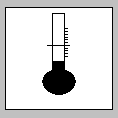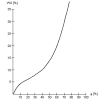| Prunes | [German version] |
Table of contents |
|
| General: | ||
| Product information | ||
| Packaging | ||
| Transport | ||
| Container transport | ||
| Cargo securing | ||
Product information
Product name
| German | Pflaumen, getrocknet (Backpflaumen) |
| English | Prunes (dried plums) |
| French | Pruneaux |
| Spanish | Ciruelas pasas |
| Scientific | Prunus domestica |
| CN/HS number * | 0813 20 00 |
(* EU Combined Nomenclature/Harmonized System)
Product description
Prunes are the fully ripe fruit still containing their stone of the plum tree (rose family, Rosaceae) which have been preserved by drying (air, sun or artificial drying) (dried fruit). The plum tree is native to Asia Minor and is now found throughout Europe and all over the world.
The following types are distinguished:
| Prunes: fresh, blue-black, glossy; form a whitish coating of crystallized sugar after extended storage. | |
| Dipped prunes: prunes which have formed a coating of crystallized sugar but regain a blue-black, glossy appearance by dipping in boiling water. | |
| Steamed prunes: prunes which have been given a glossy appearance by steam treatment. | |
| Slabs: waste product intended for industrial use. |
Quality / Duration of storage
The quality of prunes is determined by size, aroma, fleshiness and tenderness of the skin.
Fresh prunes have a blue-black, glossy appearance, are highly aromatic, with soft flesh and skin and have a sourish flavor and small stones.
Prunes which have dried out have a matt, whitish appearance due to a covering of sugar crystals.
Prunes have a storage life of several years at storage temperatures of -1 – +4°C.
Intended use
Prunes are mainly eaten raw and used as an ingredient in mixed fruit, trail mixes and muesli.
Figures
(Click on the individual Figures to enlarge them.)
 Figure 1 |
 Figure 2 |
 Figure 3 |
Countries of origin
This Table shows only a selection of the most important countries of origin and should not be thought of as exhaustive.
| Europe | France, Italy, Balkan States |
| Africa | |
| Asia | |
| America | Argentina, Chile, USA (especially California, Oregon) |
| Australia | Australia |
Back to beginning
Packaging
Prunes are packaged in, among other things, 12.5 kg paperboard cartons, plywood jointed boxes or also in flat linen fabric bags (industrial grade product).
When packaged in corrugated or millboard cartons, the product should be transported on pallets. The packaging size should be so selected that the dimensions of the individual area modules or area module multiples are conformed to the conventional pallet sizes (800×1200 mm and 1000×1200 mm) and cargo units may thus be produced.
Back to beginning
Transport
Symbols
 General cargo |
 Temperature-controlled |
Means of transport
Ship, railroad, truck
Container transport
Standard containers / refrigerated containers are used, subject to compliance with lower limits for water content of goods, packaging and container flooring.
Cargo handling
Since the packages are sensitive to impact, appropriate care must be taken during cargo handling.
In damp weather (rain, snow), the cargo must be protected from moisture, since this may lead to mold, rot, fermentation and tackiness.
Stowage factor
| 3.10 m³/t (flat linen fabric bags, 50 kg) [1] | |
| 1.20 m³/t (26 kg cartons) [1] | |
| 1.60 m³/t (boxes, 25 kg) [1] | |
| 1.69 m³/t (jointed boxes, 10.8 kg) [1] |
Stowage space requirements
Cool, dry, good ventilation if required
Segregation
Fiber rope, thin fiber nets (bags); oil crayon, marker pen (cartons)
Cargo securing
In order to ensure safe transport, the cargo must be stowed and secured in the means of transport in such a manner that it cannot slip or shift during transport. If loss of volume and degradation of quality are to be avoided, the packages must not be damaged by other articles or items of cargo.
Back to beginning
Risk factors and loss prevention
RF Temperature
Prunes require particular temperature, humidity/moisture and possibly ventilation conditions (SC VI) (storage climate conditions).
Precise details should be obtained from the consignor as to the storage temperature to be maintained.
| Designation | Temperature range | Source |
|---|---|---|
| Favorable travel temperature | 4 – 20°C | [1] |
| 10 – 15°C | [4] | |
| -1 – +4°C | [5] |
Excessively low travel temperatures cause candying due to deposition of glucose (crystallization).
At temperatures < 10°C, possible mite growth is inhibited.
Chemical reactions proceed rapidly at temperatures > 25°C and this may result in syrup formation. There is a risk of the syrup seeping out of the packaging and damaging other goods. On the other hand, they dry out, discolor and harden and, in this state, are readily infested by maggots.
The product should not be stored close to heat sources so that drying out, hardening and candying cannot occur. Temperature variations have a negative impact.
Back to beginning
RF Humidity/Moisture
Prunes require particular temperature, humidity/moisture and possibly ventilation conditions (SC VI) (storage climate conditions).
Precise details should be obtained from the consignor as to the relative humidity to be maintained.
| Designation | Humidity/water content | Source |
| Relative humidity | 60 – 70% | [1] |
| Water content | 18 – <20% | [1] |
| 24%, max. 35% | [5] | |
| Maximum equilibrium moisture content | 65% | [1] |
The steep gradient of the sorption isotherm for prunes indicates the strong hygroscopicity of these dried fruits. At a water content of 20%, prunes are at equilibrium with 60% relative humidity. At an equilibrium moisture content of 70%, the water content rises to 30%.
 Figure 4 |
Back to beginning
RF Ventilation
Prunes require particular temperature, humidity/moisture and possibly ventilation conditions (SC VI) (storage climate conditions).
If the product is at „shipping dryness“, i.e. if there is no risk of degradation by mold etc. due to water content, ventilation is not required. If this is not the case, the following ventilation measures should be implemented:
Recommended ventilation conditions: air exchange rate: 6 changes/hour (airing)
Unsuitable stowage spaces and inadequate ventilation promote heat build-up and thus syrup formation.
Back to beginning
RF Biotic activity
Prunes display 3rd order biotic activity .
They belong to the class of goods in which respiration processes are suspended, but in which biochemical, microbial and other decomposition processes still proceed.
Back to beginning
RF Gases
No risk.
Back to beginning
RF Self-heating / Spontaneous combustion
Chemical reactions proceed rapidly at temperatures > 25°C. Considerable syrup formation and self-heating may be the result.
Back to beginning
RF Odor
| Active behavior | Prunes have a slight, pleasant odor. |
| Passive behavior | Prunes are highly odor-sensitive and should not be stowed in the vicinity of onions and other alliaceous vegetables as their essential oils cause odor-tainting. |
Back to beginning
RF Contamination
| Active behavior | At temperatures > 25°C and under excessive stack pressure, syrup forms. There is a risk of the syrup seeping out of the packaging and damaging other goods. |
| Passive behavior | Prunes are extremely sensitive to contamination. |
Back to beginning
RF Mechanical influences
The packages must be secured appropriately in the hold or container so that they cannot move during transport. In the case of container transport, it is also important for the goods to be secured in the door area so that they cannot fall out of the container when the doors are opened.
Back to beginning
RF Toxicity / Hazards to health
Prunes infested by mites may cause severe gastrointestinal conditions if eaten.
Back to beginning
RF Shrinkage/Shortage
The normal weight loss due to a reduction in the moisture content of the product is approx. 1%.
Back to beginning
RF Insect infestation / Diseases
Exposure to heat and moisture may result in mite infestation, which may make the prunes inedible and cause severe gastrointestinal conditions. Mite infestation may be determined by examination with a magnifying glass: mites may be distinguished from crystallized glucose because they are whitish, slow moving dots. Development from the egg to imago (sexually mature insect) takes approx. 10 days.
Under appropriate temperature and humidity conditions, there is also a risk of infestation by cockroaches, moths (dried fruit moth, meal moth, tobacco moth), beetles (sap beetles, sawtoothed grain beetles and flour beetles), rats, mice and ants.
If infested by insects (mites, maggots etc.), prunes must be reconditioned by fumigation.
Back to beginning
